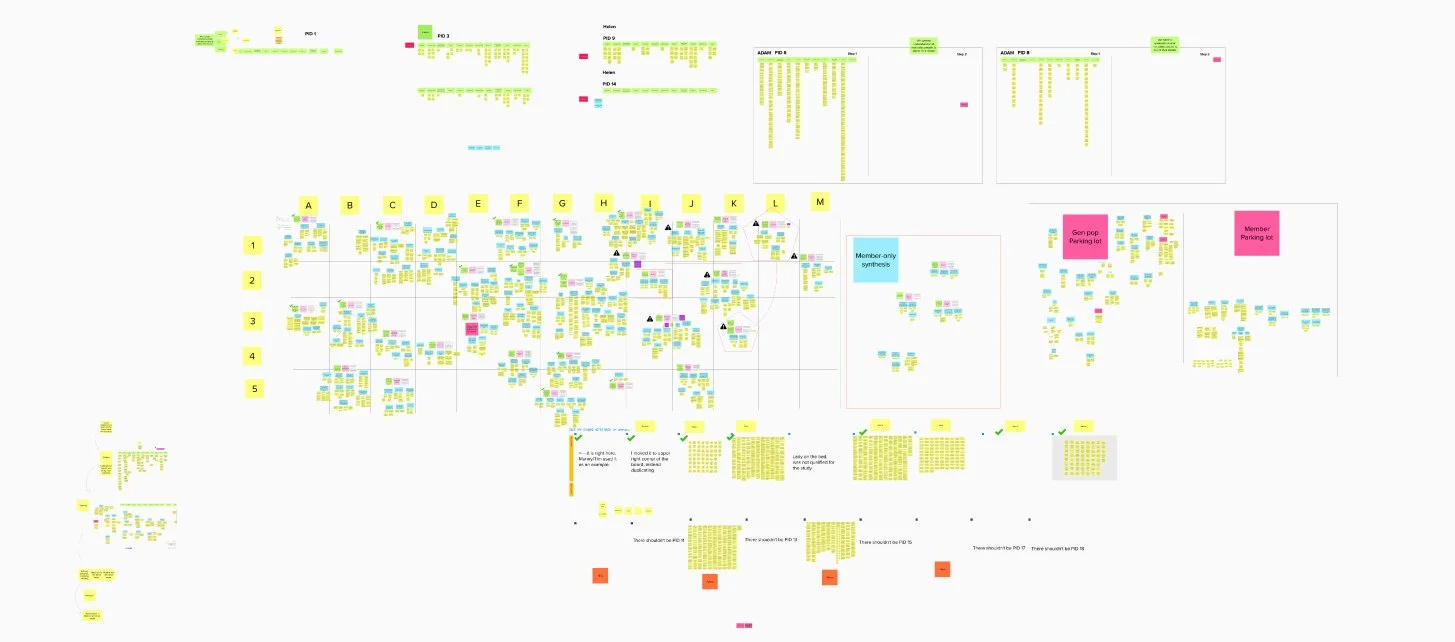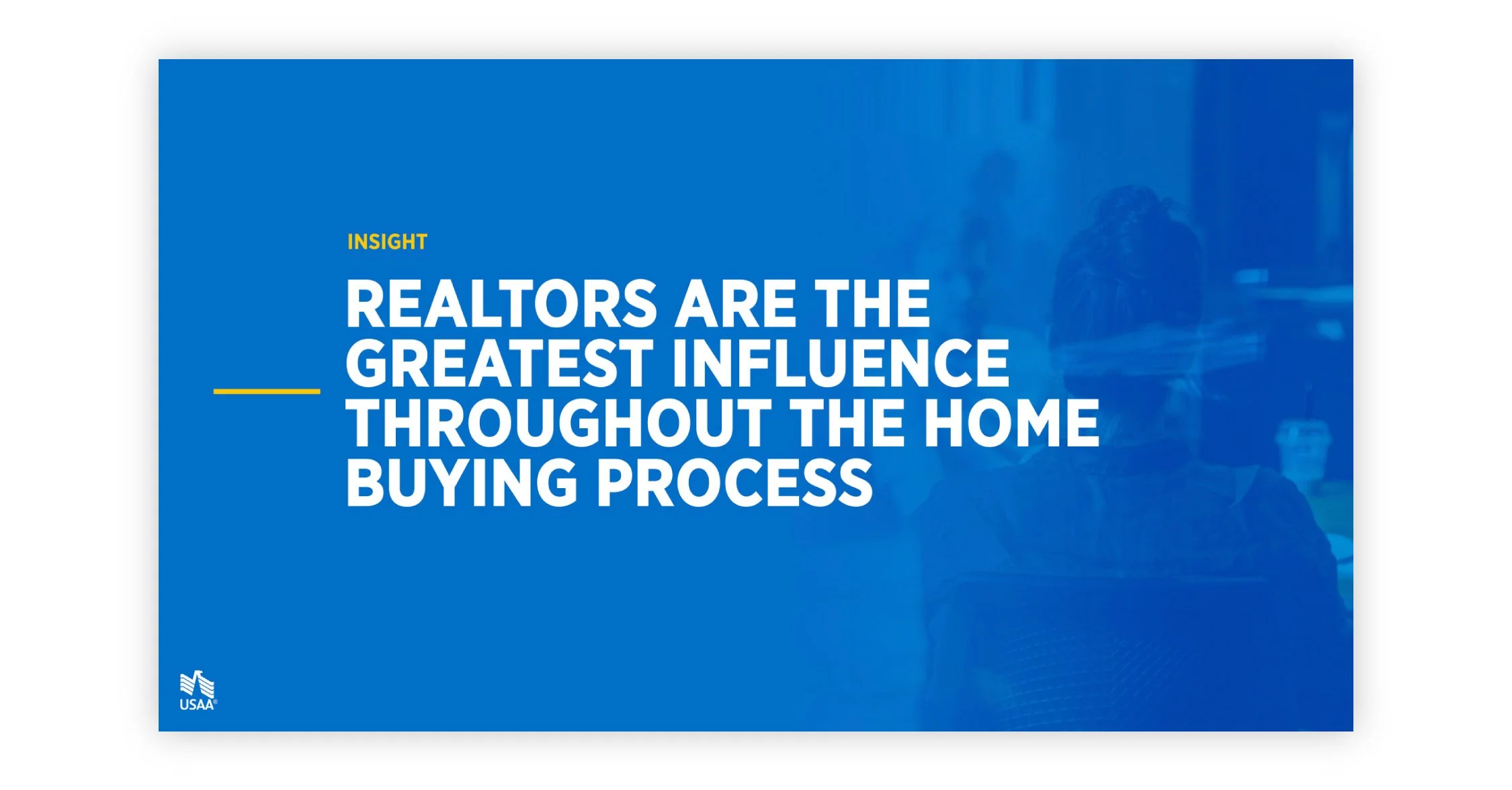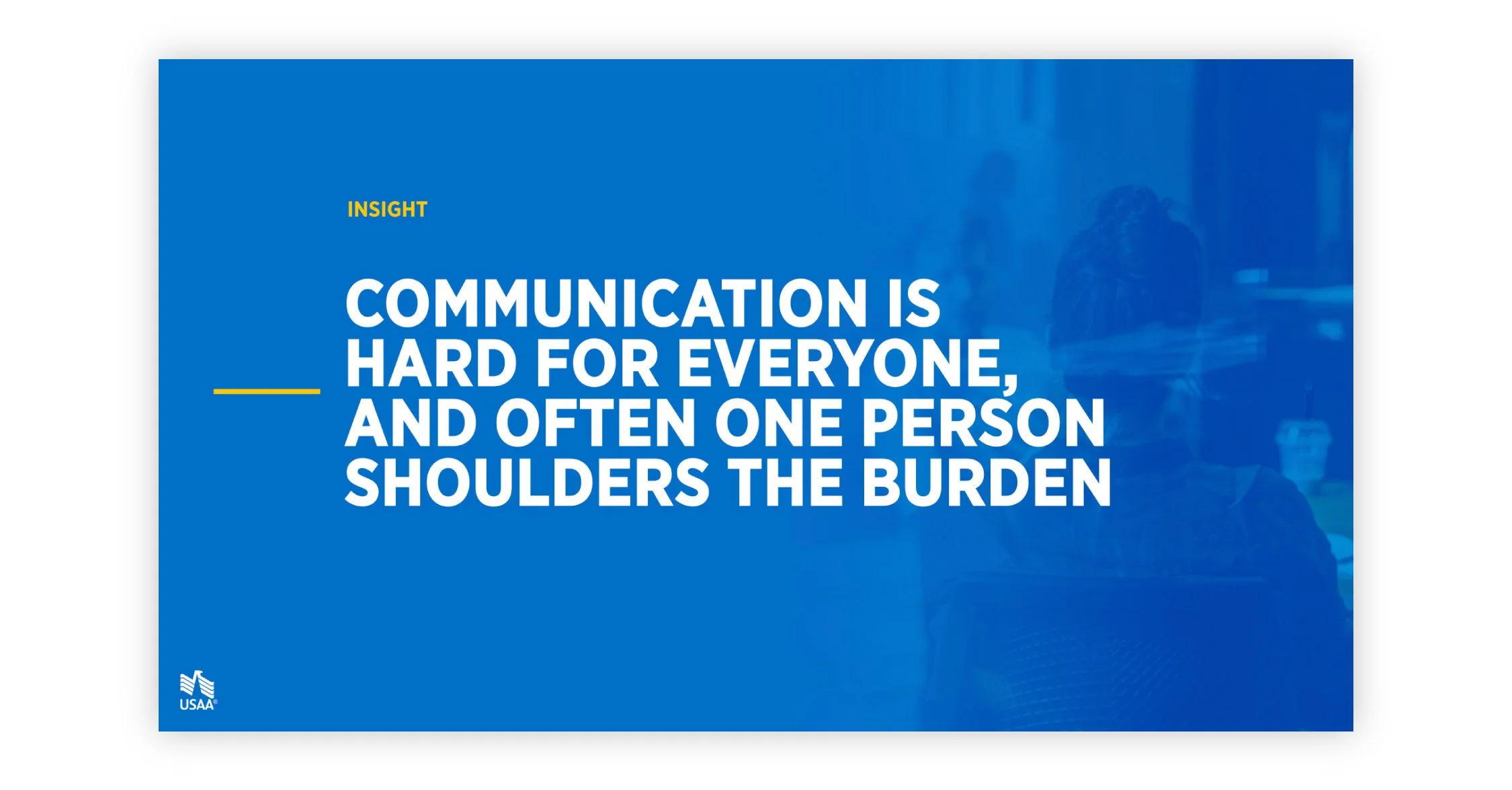UX Research: USAA
USAA Homebuying Diary Study Research
BACKGROUND
In my former role at USAA as the primary designer for our real estate line of business, my team and I conducted a year-long qualitative research effort into the real estate market homebuying experience.
PROJECT
This project was generative research, which is sometimes referred to as discovery or exploratory research. It offers deeper insight into users with the goal of understanding how they live – including their environments, behaviors, attitudes, and perceptions – in order to find opportunities for solutions and innovation.
And under the umbrella of generative research, we specifically chose to conduct a diary study. During a diary study, data is collected from participants who self-report their behaviors and experiences over an extended and defined period of time by keeping a diary and logging information about their activities.
We chose a diary study because research to-date had been primarily focused on USAA members and lacked insight into general population behaviors. Additionally, previous research had been conducted well after the mortgage transaction and relied on participants’ accurate recollection of past events. We all know how hard it can be to remember what we had for breakfast, so imagine asking people about a conversation they had with a lender months or even years ago. We wanted as close to real-time data as possible, as people experienced all the nuances of buying a home.
To accomplish this, we had to do a lot of planning, and we started with our problem statement and research goals.
Problem Statement & Methodology
Our goal with this study was to gather more in-depth contextual understanding of the consumer homebuying experience, pre-application. With this information, we hoped to better serve the needs of current and future USAA members as they navigated the homebuying process. This included recruiting only highly motivated buyers for our study, as opposed to people who were leisurely searching for homes online. We wanted to learn about the homebuying experience shared by all types of buyers, and let pain points and opportunities inspire USAA’s real estate line of business.
Participants submitted daily video entries throughout the study – the “diary” portion of the diary study – and shared what they were thinking, feeling, and doing related to homebuying. They also completed a survey at three major milestones in the process: Home shopping after preapproval, the expiration of the option period after going under contract for a home, and post-closing after the first mortgage payment was made. In addition, participants sat with us for 90-minute one-on-one interviews at each of those three milestones.
The data we ultimately gathered was from 12 participants – eight were members of the general population and four were USAA members. Each participant also completed a screener before joining the study, which required preapproval with a lender. We felt this was a good benchmark to identify highly-motivated buyers.
Along the way, however, our study did face some constraints and limitations.
Constraints & Limitations
Budget. Our study’s budget allowed us a maximum of eight weeks to compensate participants while collecting interview and survey data. Eight weeks is a short time to find and purchase a new home and, as a result, our participants had difficulty progressing through their buying journeys from home shopping to closing within our study’s timeframe. And as we all know, times have changed and made the homebuying process even more complicated, largely due to changes in the housing market, which included:
Interest rates. Our research interviews began in April 2022, which was the early stages of a rapidly accelerating interest rate environment. Average rates for a 30-year conventional mortgage hovered around 3 to 3.5% in the fall of 2021, began rising in early 2022, and increased to over 5.5% by the end of our study in August 2022, which slowed homebuying significantly.
COVID-19. As we all know, COVID-19 was declared a national emergency in the U.S. and an international pandemic in March 2020, with government-instituted restrictions having a big impact on the housing market. As a result, home inventory decreased and prices increased, making homebuying an even more difficult path for many would-be buyers – with reverberations that stretched into the timeframe of our study. Additionally, the mechanics of home shopping changed during COVID-19 and added to the challenges faced by buyers, even the most experienced ones – who quickly learned buying a home after COVID-19 was not the same as their previous homebuying experiences.
All of this resulted in a small number of participants who managed to purchase a home within the study’s eight-week timeframe. Though we recruited highly motivated buyers, many didn’t have luck securing a home during our study – even after submitting multiple offers in some cases.
Despite this, our study participants offered us a lot of insight due to their differing backgrounds, mindsets, living situations, and co-buyers with whom they were on their homebuying journeys (e.g. some lived alone, while others had partners, children, and/or multi-generational family members buying with them).
In a video from one of our 90-minute interviews, a USAA member with previous homebuying experience lamented that he wasn’t accustomed to a market as competitive as this one. As a result, he faced some new challenges, and his homebuying approach illustrated the lengths to which buyers were willing to go to get a home. To paraphrase his comments: The market is so competitive and is moving so quickly, I'm willing to buy a home sight unseen.
Many participants shared his willingness to purchase a home blindly or sight unseen because of a heightened awareness of how quickly and aggressively they needed to move to win a home offer.
Now we’ll share how we synthesized the participants’ information into homebuyer composites.
The Mural board we developed for our Homebuying Diary Study data synthesis.
Homebuyer Composites
After interviewing our diary study participants, gathering all of the interview and survey data, and synthesizing and summarizing it, we created two homebuyer composites (we considered them a combination of archetypes and personas). These two composites were Sgt. Abbott, a first-time homebuyer, and Candace, an experienced homebuyer, who together offered a generalized representation of our participants.
Sgt. Abbott, our first-time homebuyer. Sgt. Abbott is a member of the military in his early 30s. He’s married with no children, and he currently rents his home. He’s never owned before, and due to a recent change in rank and resulting pay raise, he’s finally ready to buy his first home. After years of saving and motivated by the belief that building equity is a smart financial move and affords him greater flexibility – and that renting is the equivalent of giving your money away – he begins the homebuying process by researching what the process actually is. He reads articles online, talks with family and friends, and tries to define his new home criteria as he’s making sense of the complexities of how to buy a home. He pours a great deal of time into research, but as one might expect of a first-time buyer, he’s still not particularly well-prepared and is looking for professional guidance, especially from a real estate agent who can be a one-stop source of support. In addition, Sgt. Abbott’s sense of urgency is high because his lease is expiring in a few months and he doesn’t want to renew it for another year.
Candace, our experienced homebuyer. Candace is in her early 50s, owns her home, and has owned multiple homes before. She, her spouse, and two teenaged children live in a comfortable house, but Candace is considering having her parents move in with them, since they’re at an age where they’re in need of more support. Candace and her husband decide to keep tabs on the housing market more regularly with an eye toward a better (and bigger) fit in their current town, so their kids don’t have to switch schools. She knows the buying process pretty well, knows what she can afford, and she quickly gets in contact with their old real estate agent and lender. Her biggest goals are finding the right home and ensuring her family can get the timing of buying and selling right, so they can move the proceeds from their current home into their new one. It’s a tricky balancing act, but she’s confident they can pull it off.
Our two homebuyer composites, which together offered a generalized representation of our study participants.
Comparing Journeys
In comparing the journeys of our two homebuyer composites, we discovered that first-time homebuyers were more apt to spend the majority of their time getting started – researching and navigating through the homebuying process, preparing their finances, polling friends and family for insights, learning terminologies, and gathering needed documentation, among other things. In their research, they learned how overwhelming the homebuying process could be without the help of a real estate agent, so they spent additional time searching for and selecting a real estate agent. Typically, they relied on their agent to recommend a mortgage lender, with whom they secured their preapproval.
When they arrived at the shopping phase, first-time homebuyers also had a higher level of urgency to buy a home because they often had a rental agreement with a specific expiration and/or renewal date. As a result, they exhibited some flexibility in their homebuying criteria.
Conversely, experienced homebuyers spent less time in the research and preparation phase and more time in the home search/shopping phase. They bypassed the initial onboarding time needed by first-time buyers to learn the homebuying process, and instead focused their efforts on researching specifics such as current interest rates and home prices. In addition, they quickly made decisions such as selecting a real estate agent and mortgage lender, as well as getting preapproved. They spent the bulk of their time target searching for particular home features and criteria and waiting for those homes to hit the market.
Though experienced homebuyers were accustomed to the buying journey, the current real estate market has vastly changed, as mentioned earlier. So while these buyers were well-prepared, they spent some time relearning the process and adapting to its new conditions.
Despite their differences, first-time and experienced homebuyers had several similarities and shared needs, which included:
A need for support in navigating the homebuying process
Modern digital tools to remain organized and gain a competitive edge
Connection with a real estate agent, mortgage lender, and preapproval for a mortgage
Communication and collaboration during home shopping
Opportunities
As a result of the similarities and shared needs we identified from our homebuyer composites, several opportunities for USAA became apparent to our team, including:
The opportunity to surface roadmaps and checklists to help USAA homebuyers navigate their buying journeys as they’re getting started and conducting initial research
The opportunity to leverage existing knowledge of USAA members to offer digital homebuying tools with more personalized features
The opportunity to foster and maintain relationships with real estate agents – including an exploration of methods for educating and connecting agents with USAA homebuyers
The opportunity to provide a digital solution for joint homebuyers to offer a best-in-class buying experience
Insights & Recommendations
Insight #1: Real estate agents are the greatest influence throughout the homebuying process.
Recommendation #1: USAA should invest in more research around the real estate agent experience.
Insight #2: Even experienced buyers need help navigating the homebuying process.
Recommendation #2: Evolve USAA’s existing Home Value Monitoring tool into a personal real estate and financial dashboard.
Insight #3: Communication is hard for everyone involved in the homebuying journey, and often one person shoulders the burden.
Recommendation #3: Create a modern, collaborative co-buyer digital experience.
OUTCOME
After presenting our three sets of insights and recommendations, our team delineated next steps and action plans related to each, and we concluded with a question-and-answer session.
We delivered our Homebuying Diary Study presentation separately to USAA’s chief design office and to our stakeholders, which included digital product owners, software developers, business partners, and executives. We received a great deal of positive feedback from our colleagues, and our presentation has served as a catalyst for new design opportunities with our business partners.







